Reviewer's Note: This is a detailed comparison review of the new LiteFlux LF5XT, with beamshots, throw/output numbers, runtimes, etc. (warning: pic heavy!). The LF5XT was purchased from LED Cool - see his Dealer's thread in CPFM.
Part I: Build Overview
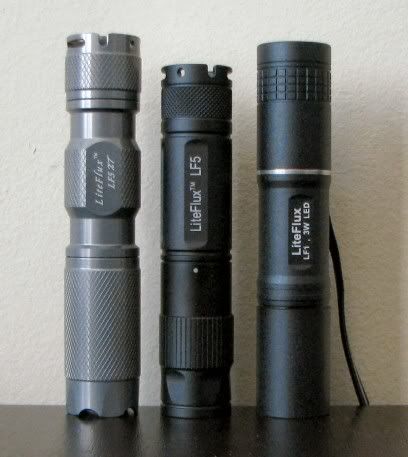
The LF5XT is the latest in a series of 1AA lights produce by Taiwanese maker LiteFlux (earlier LF5 and original LF1 shown above). This latest version uses a Cree R2 emitter and a sophisticated circuit that allows you to exquisitely control all the lights features and settings. The LF5XT is really an evolution of the earlier twisty LF5 with significant improvements and MCU (microprocessor-controller unit) clicky interface. The closest overall UI comparable would be the 1xCR123A/RCR Novatac 120P (reviewed here), but with significant differences as I'll outline below.
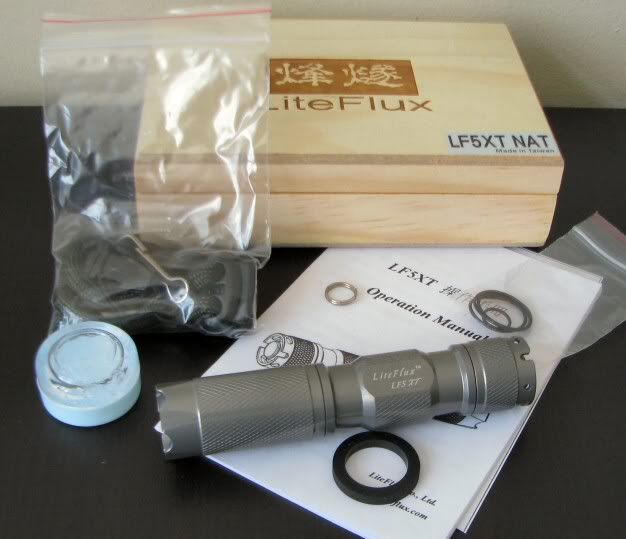
The LiteFlux packaging is similar to older LF5 series, and comes in a nice wooden presentation box. Package contains a manual, wrist strap, spare o-rings, lube, split-ring, and what appears to be a plastic grip ring for the body. The wrist strap seems to be of fairly high quality, and is a nice addition.
Body design is longer than most 1xAA lights, due to the deep reflector and other design elements (scroll down for detailed pics).
Weight: 53.9g
Length x Width: 110.6mm x 20.6mm
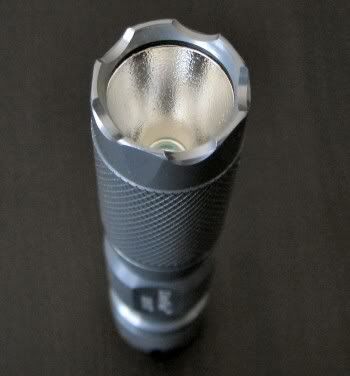
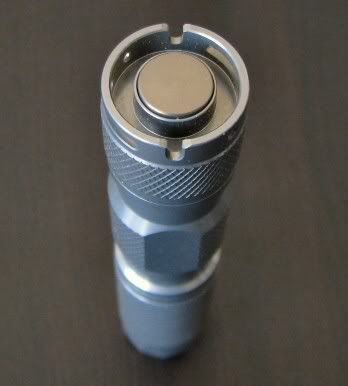
Fit and finish is outstanding on my sample - lettering is very clear and sharp, and natural gray type-III hard anodizing is flawless (also comes in black). For an amusing sidebar story of the anodizing quality, see post #2. My only minor quibble here is the stylized italic font looks a little cheesy, IMO. The knurling is extremely mild, even more so than most of the Chinese makers.

The light uses the relatively hard-to-come-by Cree R2 emitter. These don't seem to be available in guaranteed tint bins at present, but Khoo (LED Cool) has offered to pre-select tints for those who are interested. My sample features the new "silver" backed version Cree that comes from the Asian Cree assembly plant. There is a small dark discoloration on my reflector near the emitter (bottom of the above pic), but it isn't noticeable in the beam. Reflector is deeper than most 1AA lights, and is textured to smooth out the Cree rings.
Build of this light is somewhat unique. Since it uses a MCU in the head, a separate current path needs to be provided for the modes to work reliably. In the Novatac lights, this is done with a spring that runs around the battery. For the LF5XT, there is a brass sleeve that the battery sits inside, and connects the tailcap switch to the retaining ring in the head. See the detailed pics below:
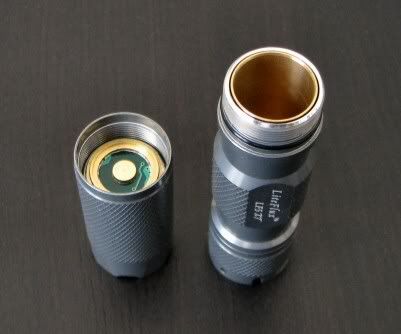

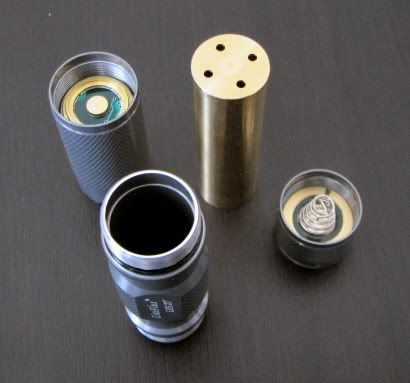
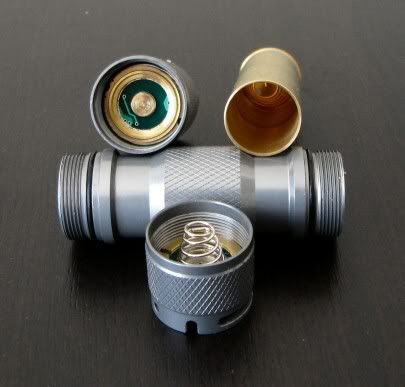
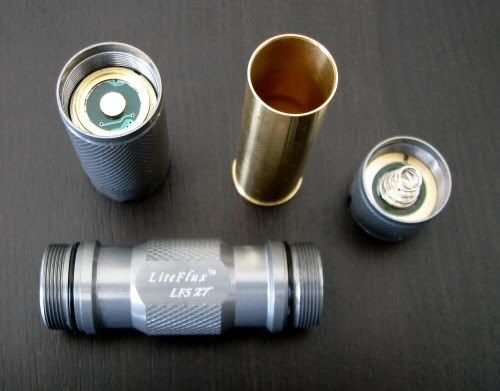
Although it may look similar to the NiteCore "Piston Drive", the LF5XT still uses an actual tailcap switch. But the switch is not your typical clicky - again, switching is actually controlled by the MCU in the head. The switch can actually be programmed by the user to function in a number of ways (e.g. momentary-on, or traditional "click" to remain on). Feel is similar to the Novatac series lights. A good way to describe it is like the on/off button press on your LCD monitor, as compared to the old switches on CRTs which are more like traditional clickies.
Note that the screw threads are anodized on both ends of the body tube, so tailcap lock-out is possible. :thumbsup:
Features and User Interface
This is where it gets a little complicated.
The LF5XT is a fully customizable light that can be configured by the user in any of a number of ways. Some of the features include:
One thing I should point out is that the interface should feel somewhat familiar to Novatac users (and to a lesser extent NiteCore D10/EX10) users, as all the lights use a series of "clicks" and "presses" to move through modes or activate features. But there is one critical difference in how the LF5XT works: a "press" in this case mean a press-and-release, not a press-and-hold as it does on the Novatac/NiteCore terminology. The difference between a click and press on the LF5XT is simply one of time - press and release with 0.4 secs and you have "clicked". Press and hold it for a bit longer before releasing, and you have "pressed". It's important you don't press-and-hold, or you won't be able to do much with your light.
As I mentioned, the UI is somewhat similar to the Novatacs, but with more features (and thus more complexity). Although the light is as easy to use in practice once programmed, I suspect you will find you need to refer to the manual frequently when you want to re-program any features. Unfortunately, the supplied manual has some language issues, so I suggest you check out that link above for a discussion of the simplified manual. Note also that the Novatac is capable of far lower low modes than the LF5XT.
This is also one of the main difference to the NiteCore and Novatac lines. On those lights, the variable output ramp can be accessed directly by a simple maneuver while using the light (although you will be setting a memory state by doing so). With the LF5XT, you have to go through the programming menus to access the ramp for a given set-able output.
I won't get into any further detail except to say I find the UI works well once you take the time to learn it (and keep the manual around for helping to figure out where you are!). If you don't like playing with these sorts of things, you might want to consider a simpler (and less customizable) light.
Part II: Comparison Review
To compare it to other members of its 1AA class, I've chosen (from left to right): the earlier LiteFlux LF5 (SSC), NiteCore D10 (Q5), Fenix L1D (Q5), JetBeam Jet-I MK IBS (Q5), and Jet-I PRO (R2).
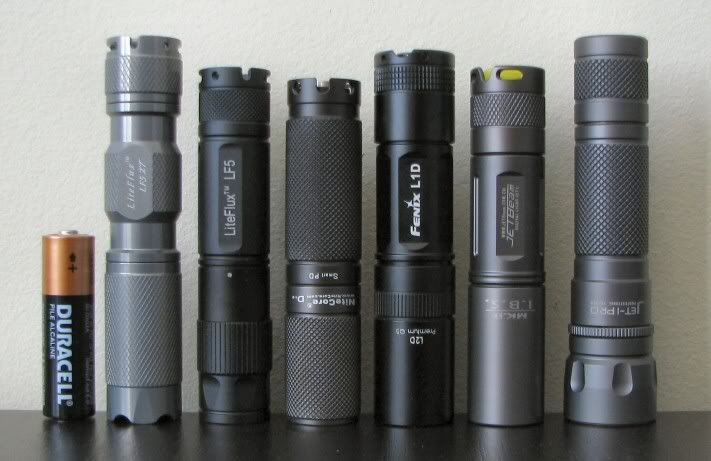
Comparison Beamshots
All lights are on 100% on 2650mAh NiMH (Duracell), about 0.5 meters from a white wall.
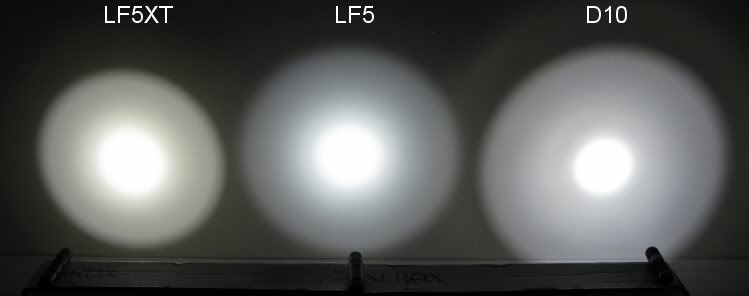
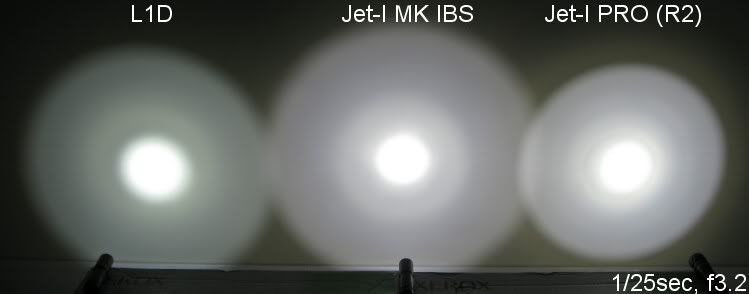
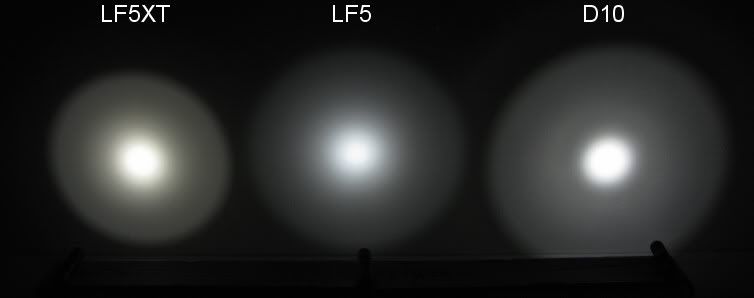
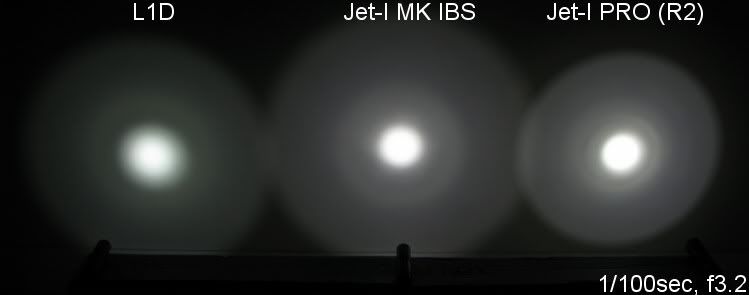
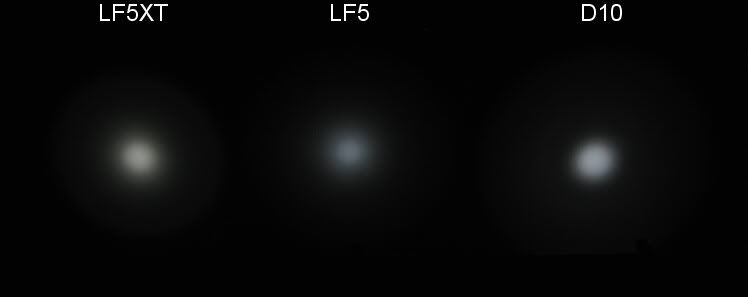
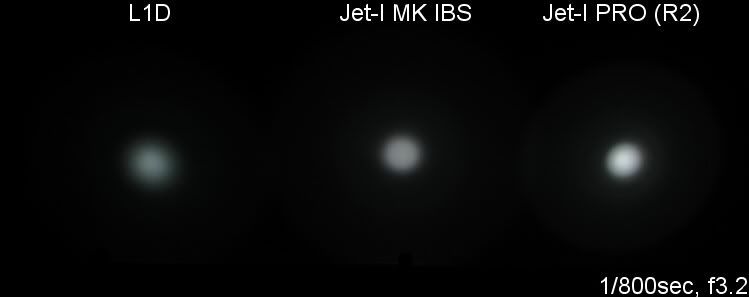
As you can see, the beam profile is very distinctive on the LF5XT - you have a much narrower (but brighter) spillbeam than most lights, thanks to the deeper reflector. Cree rings are greatly reduced, and the hotspot is a little broader on mine than most lights. Tint is quite warm, which I personally like, but there are no guarantees (unless you asked Khoo to select one for your preference).
Testing Method: All my output numbers are relative for my home-made light box setup, a la Quickbeam's flashlightreviews.com method. You can directly compare all my relative output values from different reviews - i.e. an output value of "10" in one graph is the same as "10" in another. All runtimes are done under a cooling fan, except for the extended run Lo/Min modes which are done without cooling.
Throw values are the square-root of lux measurements taken at 1 meter from the lens, using a light meter.
Throw/Output Summary Chart:
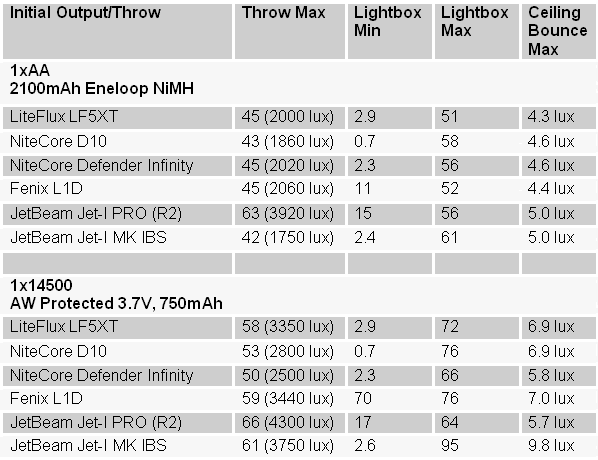
On the surface, max overall output and throw of the LF5XT seems similar to the NiteCore NDI and D10. The LF5XT doesn't go as low as the new D10, though. Note that this is based on initial brightness though - scroll down to runtimes for a more thorough investigation.
Variable Output Ramping
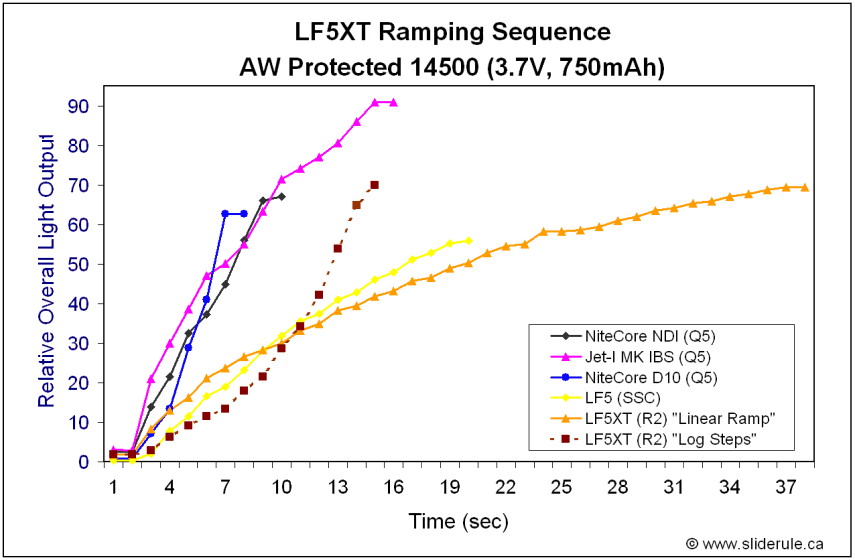
The LF5XT has two ways to adjust brightness through the settings menu - a continuously variable ramp similar to the original LF5 (orange trace above) and a step-by-step adjustment done "logarithmically" (that is to say, visually-linear) by repeated button presses (the dotted brown trace above). I've left the step-by-step trace as a dotted line, since it's not automatic and you have to advance manually at each step. Note that you can go up or down through either method easily.
As you'll see, the ramp is virtually identical to the LF5, only takes even longer to each its max or min (about 38 secs instead 20 secs). This is considerably longer than the other continuously-variable lights on the market. :shrug:
The step-by-step visually-linear method has about ~15 or so steps that I could see.
Output/Runtime Comparison:
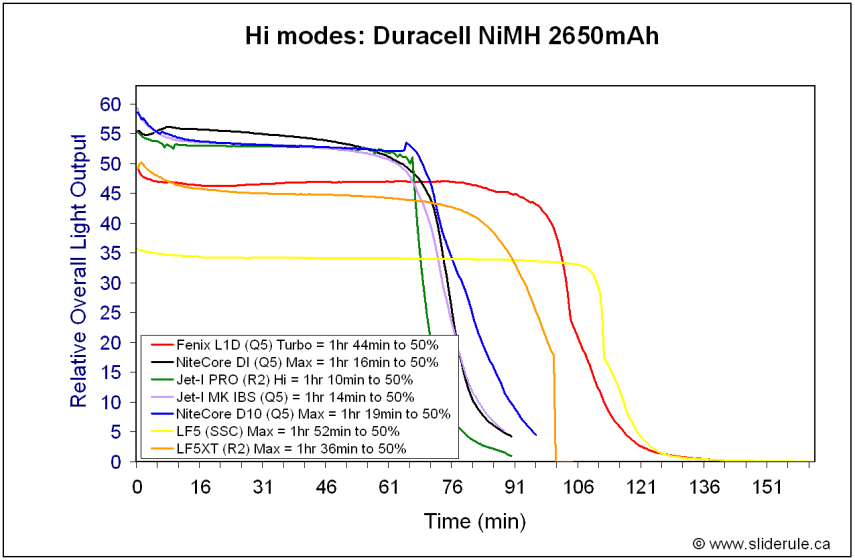
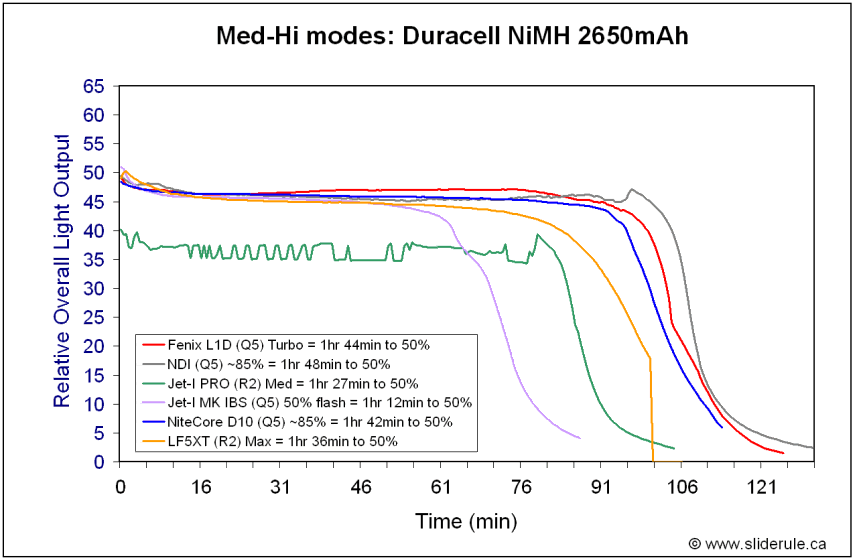
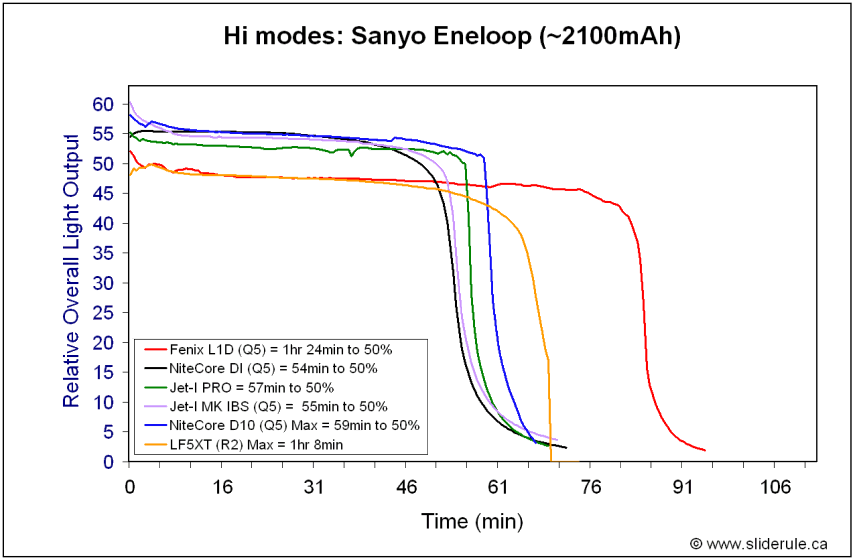
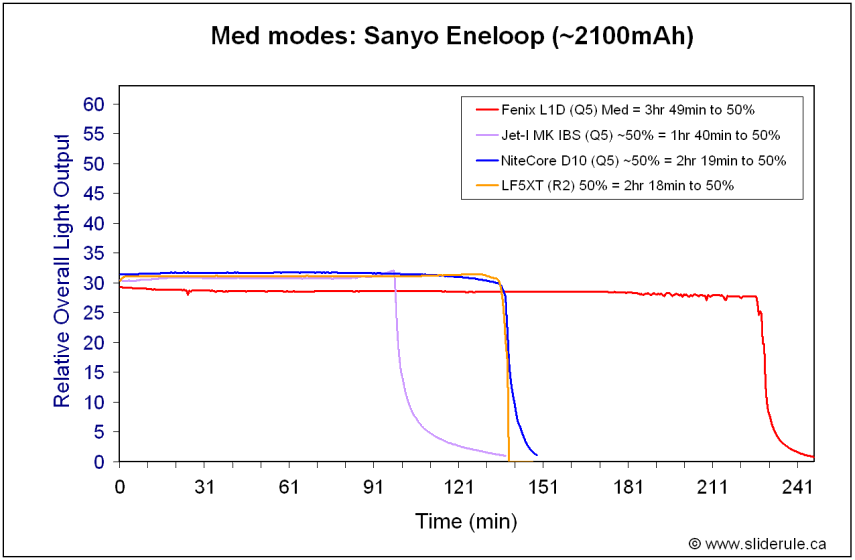
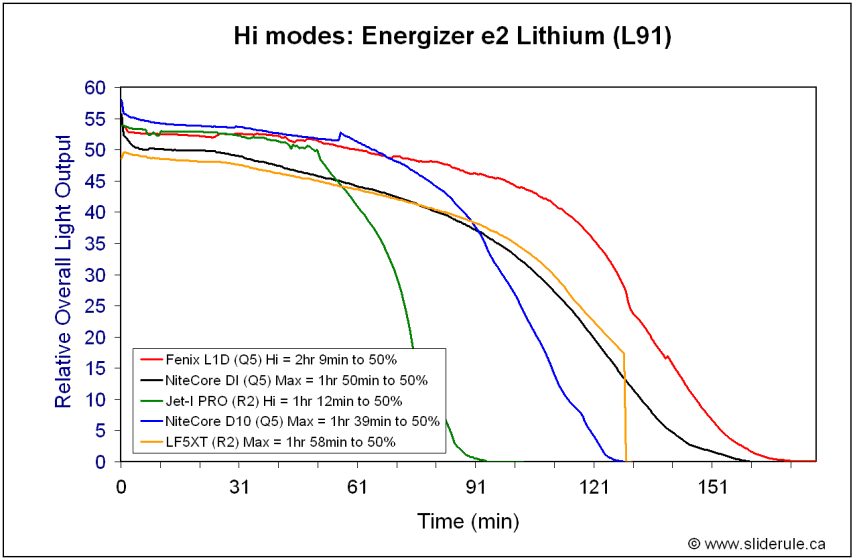
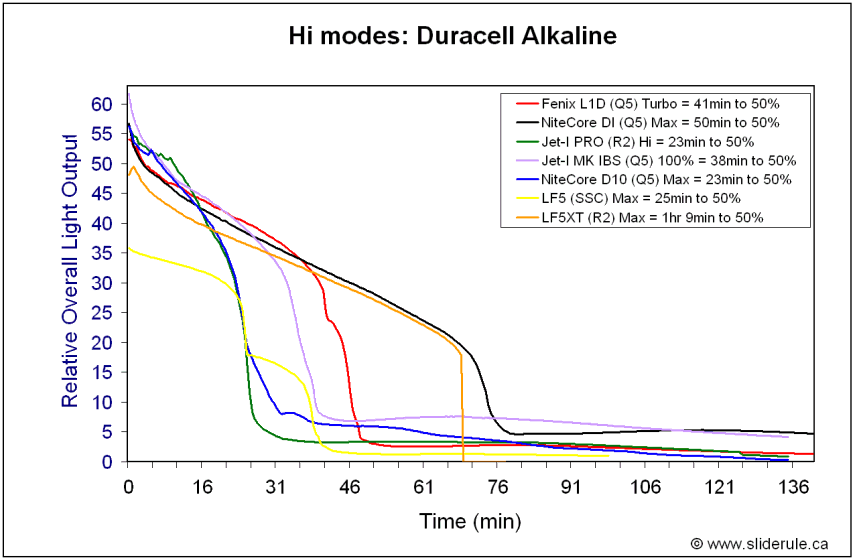

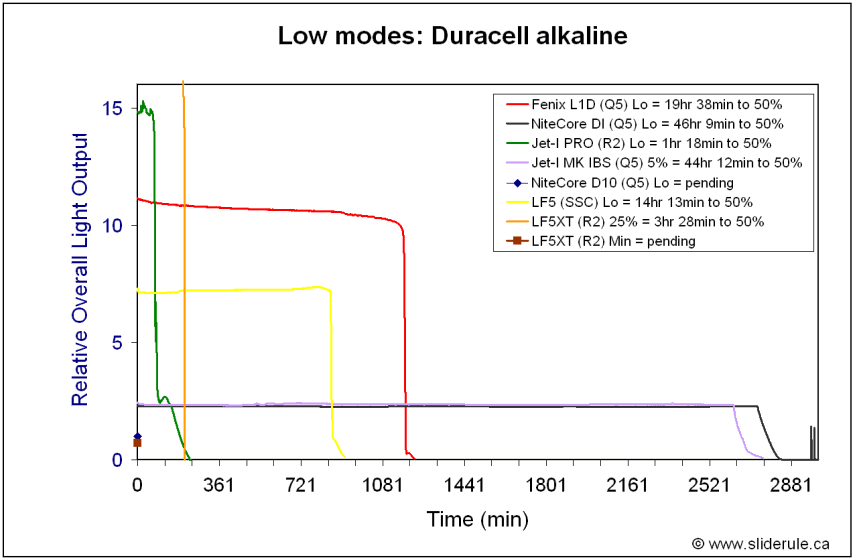
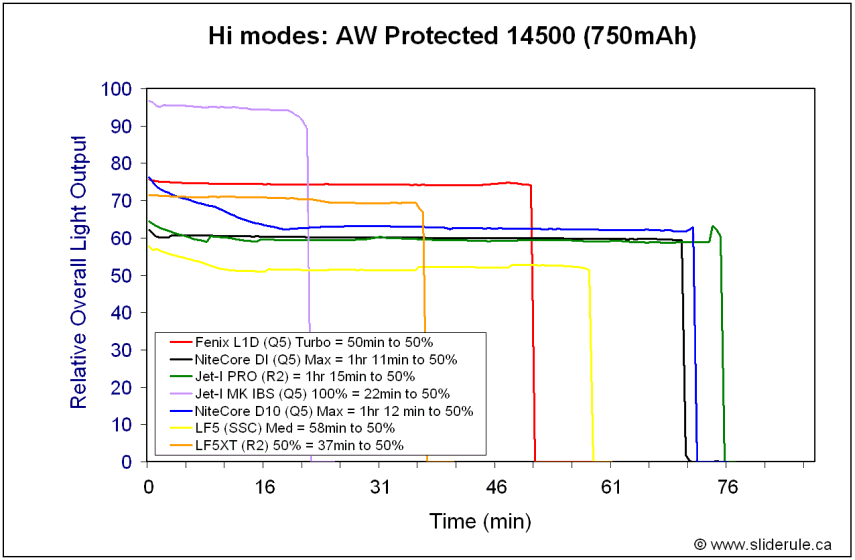


Output/Runtime Comments:
Part III: Preliminary Discussion
General Observations
The LF5XT is the most customizable and feature-rich 1AA in my collection at present. Although complicated to program, the user interface is quite easy to use in practice - once you have configured it to your satisfaction. Build quality and overall hand-feel are both excellent. I have to admit, I was a bit dubious of the original CAD drawings of the body design (I found it looked a little over-built ), but it's actually quite comfortable in the hand.
), but it's actually quite comfortable in the hand.
There are few design quirks however, which I will discuss below.
Low-voltage Shut-off Issue
I was originally a bit puzzled about the over-discharge protection feature seemingly being locked in the ON state in my light. Regardless of whether or not I set it ON or OFF in the functions menu, the NiMH cells all abruptly terminated at ~1V (i.e. about 20 on my relative output scale).
What I have come to realize is that I can only turn ON or OFF the low battery warning flash - the light will always shut-down when the cell reaches ~1V.. To see what I mean, look at the two Sanyo Eneloop runs below with the feature turned ON and OFF:
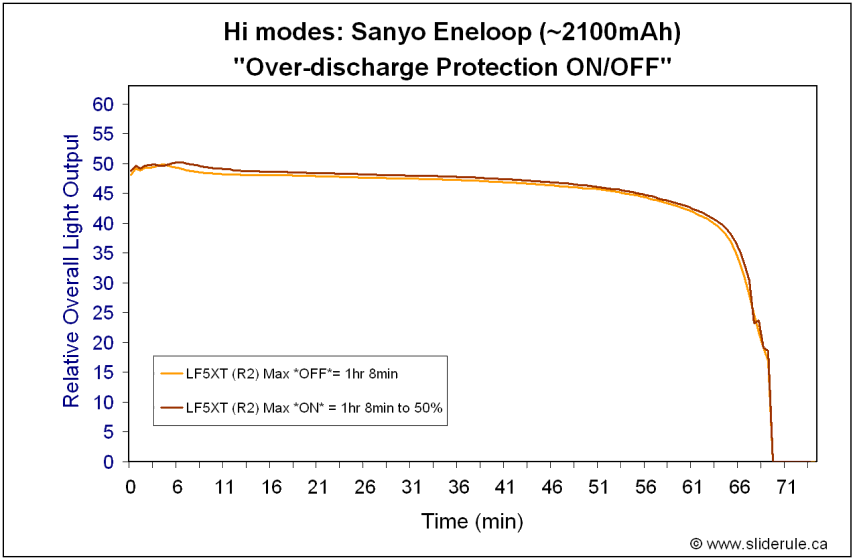
As you can see, the traces are exactly the same, except for the low-voltage warning flash shortly before shut-down. Rather than drop into a long moon mode of reduced output until the cell is exhausted, the light abruptly shuts-off at exactly the same point whether the over-discharge protection feature is engaged or not.
But then I noticed the same shut-down occurs on alkaline cells at the exact same relative output level (scroll back up to my alkaline runtimes to see what I mean). The over-discharge protection is not supposed to work on alkalines (Li-ion and NiMH only).
What seems to be happening is the light shuts off once a certain minimum circuit input voltage is reached, regardless of the cell type inside. While this is actually a very useful feature for NiMH in my view (i.e. no more risk of potentially ruined cells from over-discharging), it isn't very helpful when using alkaline cells. If all you had was an alkaline cell, you would want to be able to run it until it was dry - there's no need to terminate early. :duh2:
As it turns out, there is a work-around for this issue: after shut-down, let the depleted cell rest for a few secs/mins and the voltage will rise and you will be able to re-activate the light. Then switch to a lower output mode, and you should be able to run the light for a much longer period of time. I've just done this after one of the alkaline runs terminated, and the light ran continuously on its lowest mode with the "depleted" alkaline for over 20 hours before shutting off again. oo:
oo:
Whether or not this is a big deal depends on you - personally, I'd rather have the NiMH protection, even if it means a few other quirks. But it seems to me this issue should be resolvable for future editions.
Output and runtime efficiency
In terms of output/runtime efficiency, the LF5XT seems to be pretty well matched to the NiteCore NDI/D10s (except for max on 14500). Although maximum output on NiMH seems a little lower on my sample, and there were a few instances where the NiteCore runtimes pulled ahead, I don't know if this is significant. I have noticed a fair degree of variability among NiteCore lights, so I can't make any definite conclusions on a single LiteFlux sample. As with my Jet-I PRO (also an R2), there doesn't seem to be any clear increase in output/runtime efficiency with this particular emitter/circuit combo. But it is good to see the alkaline issues on the LF5 have been resolved in the new LF5XT. I just wish the LF5XT could go as low as the new NiteCore D10.
Interface
Although I have generally EDCed a NiteCore NDI, I have been strongly attracted to the multiple set-able states of my Novatac 120P and JetBeam IBS lights. This LiteFlux light reminds me a lot of the Novatac, although with greater programmability (and complexity). But once you've set the LF5XT the way you like, that shouldn't be an issue. It is certainly one of the most versatile lights I've come across.
Potential Issues/Recommendations
An addition to low voltage termination issue discussed above, I've noticed a few other minor issues. All PWM lights are prone to some degree of inductor whine in low modes, and this one is among the noisiest in my collection. Oddly, it is even quite noticeable on max, which is a bit uncommon. While not a big deal for me, you should be aware of it in case it's an issue for you. The PWM freq is high enough that I can't detect it by eye or instrument. :thumbsup:
A second issue is the sensitivity of the tailcap button. It's certainly a lot easier to activate than the new NiteCore piston drive, which is a point in the LF5XT's favour. However, when setting down in candle-mode, the force is usually enough to turn it off. My sample needs to be put down very gingerly to avoid this - I'd recommend LiteFlux build up the tailcap ring a little more to help prevent accidental contact.
Also, be advised that there is a 0.4 sec delay when you hit to the button before the light turns on or off. I presume the circuit is waiting to see if you are doing a press or click. Not a big deal for me (I got so used to it that I forgot the mention it in my review initially! :nana , but it is a sticking point for some.
, but it is a sticking point for some.
An area for improvement would be the manual (with an advanced interface like this one, you need to make the instructions as clear as possible). At least the font size has increased from the original LF5 manual, so it's readable now. Fortunately, there is a thread simplifying the instruction available here.
The last potential point for me is the spillbeam width, which is quite narrow because of the deep reflector. Usually, deep reflectors are used to enhance throw - but throw is really not that much greater than the NiteCore NDI/D10 in this case. It is true that the infamous Cree rings are almost completely gone - as others have commented, this almost looks like a SSC beam pattern! Scroll down to my update below to see a discussion of why this hasn't actually been an issue for me in practice.
Final (Preliminary) Word
Aside from the points above, the light has worked flawless in my testing - no mysterious mode shifts, no missed clicks, no surprises. The anodized screw threads really help with smoothness when changing batteries (something I do a lot of when testing!), and this light leaves you with a very good feeling in regards to its long-term stability. Nice solid feel with high quality parts.
EDC UPDATE:
After EDCing this light for almost a week now, I can report that I am actually really enjoying the beam. I was originally concerned about the narrow spillbeam, but haven't found it to be a major issue in practice. In fact, I was puzzled until last night as to why I didn't find it to be more of an issue (note that my major nocturnal activity these days is patrolling my house before going to bed to make sure everything is secured :huh .
.
But I've just noticed that I've been holding the LF5XT higher up, closer to my face, compared to the more general in-front-of-my-body carry that I usually do. This obviously helps casts a wider beam - funny that I didn't realize I was doing this until last night. Score one for unconscious adaptation! :laughing:
In terms of beam quality, I really like the brighter spill relative to the hotspot. As much as I liked the JetBeam Jet-I MK IBS and my Novatac 120P, I kept going back to my NDI because it had a brighter relative spill (and less defined hotspot than the Jet-I). The LF5XT is even better than the NDI/D10 in this regard - due to the narrower spillbeam.
Not sure yet which I will settle on for long-term EDC, so I think I'll keep rotating back and forth between them (i.e. week on, week off, grasshopper - if you'll pardon the mixed metaphors ). The LF5XT doesn't go as low as the D10, so that's another factor to consider. I'll keep you posted ...
). The LF5XT doesn't go as low as the D10, so that's another factor to consider. I'll keep you posted ...
Part I: Build Overview

The LF5XT is the latest in a series of 1AA lights produce by Taiwanese maker LiteFlux (earlier LF5 and original LF1 shown above). This latest version uses a Cree R2 emitter and a sophisticated circuit that allows you to exquisitely control all the lights features and settings. The LF5XT is really an evolution of the earlier twisty LF5 with significant improvements and MCU (microprocessor-controller unit) clicky interface. The closest overall UI comparable would be the 1xCR123A/RCR Novatac 120P (reviewed here), but with significant differences as I'll outline below.

The LiteFlux packaging is similar to older LF5 series, and comes in a nice wooden presentation box. Package contains a manual, wrist strap, spare o-rings, lube, split-ring, and what appears to be a plastic grip ring for the body. The wrist strap seems to be of fairly high quality, and is a nice addition.
Body design is longer than most 1xAA lights, due to the deep reflector and other design elements (scroll down for detailed pics).
Weight: 53.9g
Length x Width: 110.6mm x 20.6mm


Fit and finish is outstanding on my sample - lettering is very clear and sharp, and natural gray type-III hard anodizing is flawless (also comes in black). For an amusing sidebar story of the anodizing quality, see post #2. My only minor quibble here is the stylized italic font looks a little cheesy, IMO. The knurling is extremely mild, even more so than most of the Chinese makers.

The light uses the relatively hard-to-come-by Cree R2 emitter. These don't seem to be available in guaranteed tint bins at present, but Khoo (LED Cool) has offered to pre-select tints for those who are interested. My sample features the new "silver" backed version Cree that comes from the Asian Cree assembly plant. There is a small dark discoloration on my reflector near the emitter (bottom of the above pic), but it isn't noticeable in the beam. Reflector is deeper than most 1AA lights, and is textured to smooth out the Cree rings.
Build of this light is somewhat unique. Since it uses a MCU in the head, a separate current path needs to be provided for the modes to work reliably. In the Novatac lights, this is done with a spring that runs around the battery. For the LF5XT, there is a brass sleeve that the battery sits inside, and connects the tailcap switch to the retaining ring in the head. See the detailed pics below:





Although it may look similar to the NiteCore "Piston Drive", the LF5XT still uses an actual tailcap switch. But the switch is not your typical clicky - again, switching is actually controlled by the MCU in the head. The switch can actually be programmed by the user to function in a number of ways (e.g. momentary-on, or traditional "click" to remain on). Feel is similar to the Novatac series lights. A good way to describe it is like the on/off button press on your LCD monitor, as compared to the old switches on CRTs which are more like traditional clickies.
Note that the screw threads are anodized on both ends of the body tube, so tailcap lock-out is possible. :thumbsup:
Features and User Interface
This is where it gets a little complicated.
The LF5XT is a fully customizable light that can be configured by the user in any of a number of ways. Some of the features include:
- Wide input voltage (1.0V - 4.5V) and battery compatibility (i.e. alkaline, NiMH, NiCd, L91, 14500)
- Fully customizable set of output levels. Output is adjustable in programming mode only, through both a continuously-variable output ramp, and visually-linear step system.
- Choice of 3- or 5- configurable set states that the user can program independently and access through button presses
- Multiple strobe, SOS, and beacon modes of variable output the user can select (or avoid completely if they want)
- Additional quick access modes
- Momentary-on or standard click to lock on modes
- Low NiMH/Li-ion voltage over-discharge protection and warning system
- Ability to have it remember last mode used, or to proceed through the set states in sequence every time.
- And the list goes on ...
One thing I should point out is that the interface should feel somewhat familiar to Novatac users (and to a lesser extent NiteCore D10/EX10) users, as all the lights use a series of "clicks" and "presses" to move through modes or activate features. But there is one critical difference in how the LF5XT works: a "press" in this case mean a press-and-release, not a press-and-hold as it does on the Novatac/NiteCore terminology. The difference between a click and press on the LF5XT is simply one of time - press and release with 0.4 secs and you have "clicked". Press and hold it for a bit longer before releasing, and you have "pressed". It's important you don't press-and-hold, or you won't be able to do much with your light.
As I mentioned, the UI is somewhat similar to the Novatacs, but with more features (and thus more complexity). Although the light is as easy to use in practice once programmed, I suspect you will find you need to refer to the manual frequently when you want to re-program any features. Unfortunately, the supplied manual has some language issues, so I suggest you check out that link above for a discussion of the simplified manual. Note also that the Novatac is capable of far lower low modes than the LF5XT.
This is also one of the main difference to the NiteCore and Novatac lines. On those lights, the variable output ramp can be accessed directly by a simple maneuver while using the light (although you will be setting a memory state by doing so). With the LF5XT, you have to go through the programming menus to access the ramp for a given set-able output.
I won't get into any further detail except to say I find the UI works well once you take the time to learn it (and keep the manual around for helping to figure out where you are!). If you don't like playing with these sorts of things, you might want to consider a simpler (and less customizable) light.
Part II: Comparison Review
To compare it to other members of its 1AA class, I've chosen (from left to right): the earlier LiteFlux LF5 (SSC), NiteCore D10 (Q5), Fenix L1D (Q5), JetBeam Jet-I MK IBS (Q5), and Jet-I PRO (R2).

Comparison Beamshots
All lights are on 100% on 2650mAh NiMH (Duracell), about 0.5 meters from a white wall.






As you can see, the beam profile is very distinctive on the LF5XT - you have a much narrower (but brighter) spillbeam than most lights, thanks to the deeper reflector. Cree rings are greatly reduced, and the hotspot is a little broader on mine than most lights. Tint is quite warm, which I personally like, but there are no guarantees (unless you asked Khoo to select one for your preference).
Testing Method: All my output numbers are relative for my home-made light box setup, a la Quickbeam's flashlightreviews.com method. You can directly compare all my relative output values from different reviews - i.e. an output value of "10" in one graph is the same as "10" in another. All runtimes are done under a cooling fan, except for the extended run Lo/Min modes which are done without cooling.
Throw values are the square-root of lux measurements taken at 1 meter from the lens, using a light meter.
Throw/Output Summary Chart:

On the surface, max overall output and throw of the LF5XT seems similar to the NiteCore NDI and D10. The LF5XT doesn't go as low as the new D10, though. Note that this is based on initial brightness though - scroll down to runtimes for a more thorough investigation.
Variable Output Ramping

The LF5XT has two ways to adjust brightness through the settings menu - a continuously variable ramp similar to the original LF5 (orange trace above) and a step-by-step adjustment done "logarithmically" (that is to say, visually-linear) by repeated button presses (the dotted brown trace above). I've left the step-by-step trace as a dotted line, since it's not automatic and you have to advance manually at each step. Note that you can go up or down through either method easily.
As you'll see, the ramp is virtually identical to the LF5, only takes even longer to each its max or min (about 38 secs instead 20 secs). This is considerably longer than the other continuously-variable lights on the market. :shrug:
The step-by-step visually-linear method has about ~15 or so steps that I could see.
Output/Runtime Comparison:











Output/Runtime Comments:
- First off, I would say that the output and overall output/runtime efficiency are roughly similar to the NiteCore NDI and D10. With the exception of the 14500 runtime on max (where the LF5XT does poorly), the NDI/D10 typically only has a small runtime advantage, at best. The output of the LF5XT on standard cells seems a little lower (closer to the Fenix L1D).
- There is a peculiarity of the LF5XT circuit in regards to low voltage - see my discussion of the low-voltage shut-off issue below (note that the over-discharge protection is off in the above traces). :thinking:
- Nice to see the efficiency problems of the original LF5 on alkalines have been fixed.
Part III: Preliminary Discussion
General Observations
The LF5XT is the most customizable and feature-rich 1AA in my collection at present. Although complicated to program, the user interface is quite easy to use in practice - once you have configured it to your satisfaction. Build quality and overall hand-feel are both excellent. I have to admit, I was a bit dubious of the original CAD drawings of the body design (I found it looked a little over-built
There are few design quirks however, which I will discuss below.
Low-voltage Shut-off Issue
I was originally a bit puzzled about the over-discharge protection feature seemingly being locked in the ON state in my light. Regardless of whether or not I set it ON or OFF in the functions menu, the NiMH cells all abruptly terminated at ~1V (i.e. about 20 on my relative output scale).
What I have come to realize is that I can only turn ON or OFF the low battery warning flash - the light will always shut-down when the cell reaches ~1V.. To see what I mean, look at the two Sanyo Eneloop runs below with the feature turned ON and OFF:

As you can see, the traces are exactly the same, except for the low-voltage warning flash shortly before shut-down. Rather than drop into a long moon mode of reduced output until the cell is exhausted, the light abruptly shuts-off at exactly the same point whether the over-discharge protection feature is engaged or not.
But then I noticed the same shut-down occurs on alkaline cells at the exact same relative output level (scroll back up to my alkaline runtimes to see what I mean). The over-discharge protection is not supposed to work on alkalines (Li-ion and NiMH only).
What seems to be happening is the light shuts off once a certain minimum circuit input voltage is reached, regardless of the cell type inside. While this is actually a very useful feature for NiMH in my view (i.e. no more risk of potentially ruined cells from over-discharging), it isn't very helpful when using alkaline cells. If all you had was an alkaline cell, you would want to be able to run it until it was dry - there's no need to terminate early. :duh2:
As it turns out, there is a work-around for this issue: after shut-down, let the depleted cell rest for a few secs/mins and the voltage will rise and you will be able to re-activate the light. Then switch to a lower output mode, and you should be able to run the light for a much longer period of time. I've just done this after one of the alkaline runs terminated, and the light ran continuously on its lowest mode with the "depleted" alkaline for over 20 hours before shutting off again.
Whether or not this is a big deal depends on you - personally, I'd rather have the NiMH protection, even if it means a few other quirks. But it seems to me this issue should be resolvable for future editions.
Output and runtime efficiency
In terms of output/runtime efficiency, the LF5XT seems to be pretty well matched to the NiteCore NDI/D10s (except for max on 14500). Although maximum output on NiMH seems a little lower on my sample, and there were a few instances where the NiteCore runtimes pulled ahead, I don't know if this is significant. I have noticed a fair degree of variability among NiteCore lights, so I can't make any definite conclusions on a single LiteFlux sample. As with my Jet-I PRO (also an R2), there doesn't seem to be any clear increase in output/runtime efficiency with this particular emitter/circuit combo. But it is good to see the alkaline issues on the LF5 have been resolved in the new LF5XT. I just wish the LF5XT could go as low as the new NiteCore D10.
Interface
Although I have generally EDCed a NiteCore NDI, I have been strongly attracted to the multiple set-able states of my Novatac 120P and JetBeam IBS lights. This LiteFlux light reminds me a lot of the Novatac, although with greater programmability (and complexity). But once you've set the LF5XT the way you like, that shouldn't be an issue. It is certainly one of the most versatile lights I've come across.
Potential Issues/Recommendations
An addition to low voltage termination issue discussed above, I've noticed a few other minor issues. All PWM lights are prone to some degree of inductor whine in low modes, and this one is among the noisiest in my collection. Oddly, it is even quite noticeable on max, which is a bit uncommon. While not a big deal for me, you should be aware of it in case it's an issue for you. The PWM freq is high enough that I can't detect it by eye or instrument. :thumbsup:
A second issue is the sensitivity of the tailcap button. It's certainly a lot easier to activate than the new NiteCore piston drive, which is a point in the LF5XT's favour. However, when setting down in candle-mode, the force is usually enough to turn it off. My sample needs to be put down very gingerly to avoid this - I'd recommend LiteFlux build up the tailcap ring a little more to help prevent accidental contact.
Also, be advised that there is a 0.4 sec delay when you hit to the button before the light turns on or off. I presume the circuit is waiting to see if you are doing a press or click. Not a big deal for me (I got so used to it that I forgot the mention it in my review initially! :nana
An area for improvement would be the manual (with an advanced interface like this one, you need to make the instructions as clear as possible). At least the font size has increased from the original LF5 manual, so it's readable now. Fortunately, there is a thread simplifying the instruction available here.
The last potential point for me is the spillbeam width, which is quite narrow because of the deep reflector. Usually, deep reflectors are used to enhance throw - but throw is really not that much greater than the NiteCore NDI/D10 in this case. It is true that the infamous Cree rings are almost completely gone - as others have commented, this almost looks like a SSC beam pattern! Scroll down to my update below to see a discussion of why this hasn't actually been an issue for me in practice.
Final (Preliminary) Word
Aside from the points above, the light has worked flawless in my testing - no mysterious mode shifts, no missed clicks, no surprises. The anodized screw threads really help with smoothness when changing batteries (something I do a lot of when testing!), and this light leaves you with a very good feeling in regards to its long-term stability. Nice solid feel with high quality parts.
EDC UPDATE:
After EDCing this light for almost a week now, I can report that I am actually really enjoying the beam. I was originally concerned about the narrow spillbeam, but haven't found it to be a major issue in practice. In fact, I was puzzled until last night as to why I didn't find it to be more of an issue (note that my major nocturnal activity these days is patrolling my house before going to bed to make sure everything is secured :huh
But I've just noticed that I've been holding the LF5XT higher up, closer to my face, compared to the more general in-front-of-my-body carry that I usually do. This obviously helps casts a wider beam - funny that I didn't realize I was doing this until last night. Score one for unconscious adaptation! :laughing:
In terms of beam quality, I really like the brighter spill relative to the hotspot. As much as I liked the JetBeam Jet-I MK IBS and my Novatac 120P, I kept going back to my NDI because it had a brighter relative spill (and less defined hotspot than the Jet-I). The LF5XT is even better than the NDI/D10 in this regard - due to the narrower spillbeam.
Not sure yet which I will settle on for long-term EDC, so I think I'll keep rotating back and forth between them (i.e. week on, week off, grasshopper - if you'll pardon the mixed metaphors
Last edited:


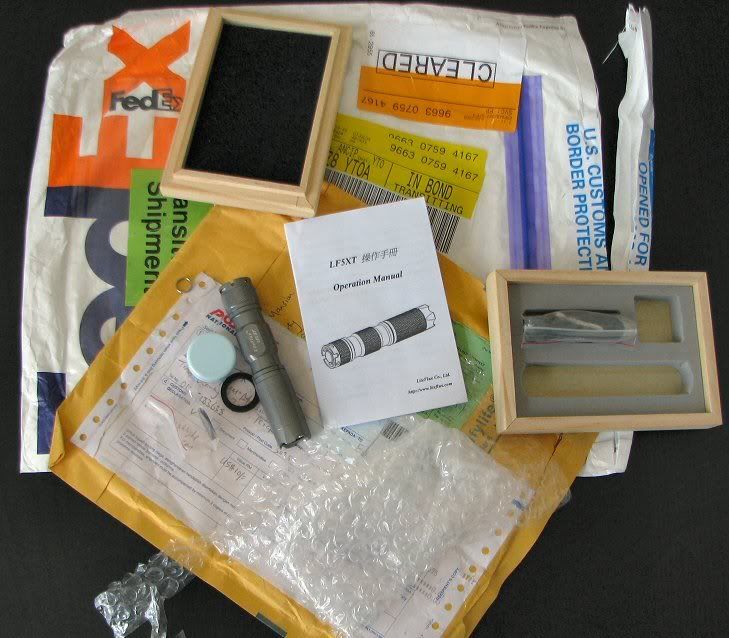

 .. That part of Selfbuilt's review led me to believe it was possible - and that I had just missed something in the programing possibilities.
.. That part of Selfbuilt's review led me to believe it was possible - and that I had just missed something in the programing possibilities.